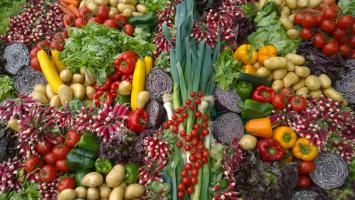
AYURVEDA PHARMACOLOGY OF FOOD & HERBS
CLASSIFICATION OF FOOD, HERBS, & LIFESTYLE
Browse Recipes AYURVEDIC PERSPECTIVE ON GRAINSGrains are seeds from the grass or buckwheat family. Grains are sweet and heavy, but are generally less oily than nuts & seeds. Autumn and winter are the best time of year for grain consumption. Since most grains are gooey, they should be minimized during Spring, the "gooey" time of year.The amount of grains you consume depends on what your body! The most simple and clear way to regulate your dose of grains is by checking the thickness of your mucus in the sinuses. If your mucus is thin you may actually need more grains to sweeten your blood. If your mucus is profuse or thick, that is a sign to back off of heavy, gooey foods and grains like wheat. In general, grains have a high energy density, and aggravate heavy, gooey, sticky, oily, and thick conditions in your body, such as mucus mentioned above, or weight gain. Other symptoms you have too much gooeyness in your blood for grain consumption include a oily skin, acne, and oily hair. Not all grains are gooey and heavy. If you have the conditions above, favor light grains instead. There is a range of qualities in grains though from heavy to light, or cooling to warming. Here's a list of grains to start from. Click on one of the grains below to learn ore about it.
When you purchase and prepare grains, remember that whole grains have more fiber and are slower to digest, which will sustain your energy levels longer and won't cause a crash. It takes more energy to break down the hull, bran and germ of the grain, which gives your digestion a good workout and keeps you feeling satisfied longer. If your digestion is weak and you need more nourishing properties, white basmati rice is a great choice. Soaking your GrainsSoaking grains in advance remove the phytic acid. Phytic acid is a chemical that resides in the hull of the grain and protects it from insects and weather. It's the reason that rice remains edible for so long after picking. But you don't want to eat it! Phytic acid is such a good defense system, that it can't be broken down by digestive juices in your stomach. It inhibits your ability to absorb the proteins of the grains. Soaking them and tossing out the water removes the phytic acid, enabling you to benefit as much as possible from hearty, nourishing, whole grains.Light, gluten free grains like quinoa, amaranth, buckwheat, millet, corn should be soaked for thirty minutes before cooking if desired. Heavy grains like barley, wheat, rice, Farro- a delicious Italian strain of wheat, kamut-strain of wheat, & rye can be soaked for two hours prior to consumption. Dinner IdeaJapanese Soba Noodles are made with buckwheat, one of the lighter, gluten free grains. Most of us love pasta, or any kind of noodle. When made with refined flour, or even whole wheat, they can be very heavy to digest. Soba Noodles satisfy the part of us that loves pasta. You can make them into a clear broth soup with miso, various mushrooms and sprouts. Or substitute this noodle in classic pasta dishes like Pasta Puttanesca, Pasta Primavera or good old Spaghetti.Grains Recipes Listed By StrengthBrowse By Popularity

About the Author John Immel, the founder of Joyful Belly, teaches people how to have a healthy diet and lifestyle with Ayurveda biocharacteristics. His approach to Ayurveda is clinical, yet exudes an ease which many find enjoyable and insightful. John also directs Joyful Belly's School of Ayurveda, offering professional clinical training in Ayurveda for over 15 years.John's interest in Ayurveda and specialization in digestive tract pathology was inspired by a complex digestive disorder acquired from years of international travel, as well as public service work in South Asia. John's commitment to the detailed study of digestive disorders reflects his zeal to get down to the roots of the problem. His hope and belief in the capacity of each & every client to improve their quality of life is nothing short of a personal passion. John's creativity in the kitchen and delight in cooking for others comes from his family oriented upbringing. In addition to his certification in Ayurveda, John holds a bachelor's degree in mathematics from Harvard University. John enjoys sharing Ayurveda within the context of his Catholic roots, and finds Ayurveda gives him an opportunity to participate in the healing mission of the Church. Jesus expressed God's love by feeding and healing the sick. That kindness is the fundamental ministry of Ayurveda as well. Outside of work, John enjoys spending time with his wife and 6 kids, and pursuing his love of theology, philosophy, and language. | |||||||||||||||||||||||||
Join Joyful Belly.
Want our top Ayurvedic recipes and health tips?Subscribe to our free newsletter!








 On MeWe
On MeWe On Pinterest
On Pinterest On Facebook
On Facebook On Twitter
On Twitter On WhatsApp
On WhatsApp On Email
On Email













